Uncovering the Past of Historical Fairy Tales and Its Perpetual Delight.
Uncovering the Past of Historical Fairy Tales and Its Perpetual Delight.
Blog Article

Popular fairy tales have ancient roots. These tales have been told from one generation to the next well before they were ever inscribed. They came from a variety of backgrounds, including Asian traditions. They were initially disseminated among mature audiences, often carrying themes and messages relevant to the societal norms and beliefs of the time.
The famous Grimm duo, Jacob and Wilhelm, were among the first to gather many of these beloved stories. Their volume, "Grimm's Fables," included narratives like "Cinderella," "Hansel and Grethel," and "Snow-White and Rose-Red," which have since become classics in the world of timeless fairy tales. Similarly, Hans Andersen's fanciful tales, such as "The Mermaid's Tale," and "The Little Duckling," have stolen hearts worldwide, solidifying their place in the pantheon of iconic fairy tales.
Despite their age, fairy tales remain as meaningful as ever, especially as nighttime stories for kids. These whimsical stories are now available in diverse formats, including vibrantly illustrated books, fantastical animations, and web-based fairy tales.
Their enduring popularity can be connected to several charming aspects:
Moral Lessons: Ancient fairy tales often whisper important moral lessons. Tales like "The Shepherd Boy and the Wolf" teach the merit of truthfulness, while "The Race of the Tortoise and the Hare" stress the qualities of tenacity and modesty. These tales offer kids clear distinctions between correct and incorrect, shaping their moral compass in a mild yet profound way.
Empathy and Understanding: Classic fairy tales frequently feature heroines facing tests and troubles, provoking children to connect with their struggles and encourage their triumphs. For instance, "Beauty and Her Beast" emphasizes the importance of seeing beyond the surface to know the true being of a character, developing understanding and recognition.
Cultural Perception: Many old fairy tales are rooted in the cultural contexts from which they emerged. Discovering these tales can provide informative snapshots into different historical contexts, strengthening a sense of cultural appreciation and perception.
Creativity and Imagination: The fantasy-filled elements in fairy tales—fairy godmothers—boost children’s visions and dreams. These fairy tales transport readers to fantasy realms, enlivening imaginative dreams and a sense of wonder that stays a lifetime.
Classic fairy tales are not only delightful but also pedagogical. They function as magical tools in fostering various mental and emotional abilities in young readers. When traditional fairy tales are spoken, they nurture linguistic abilities by offering new lexicon and detailed sentence structures. This practice also enhances listening abilities and attentiveness, as kids listen intently, anticipating to see what happens next.
Furthermore, conversing about the themes and characters of classic fairy tales can develop problem-solving abilities and analytical skills. Young ones are guided to notice patterns, forecast, and figure out cause and effect. These reflections also benefit young ones voice their thoughts and feelings, strengthening their emotional intelligence.
In today’s electronic age, the proliferation of digital storybooks has made these stories more acquirable than ever. Internet resources and software present huge assortments of ancient fairy tales that can be read or listened to anytime, anywhere. Fairy these guys tales read out loud are particularly sought after, sharing an captivating way for children to delight in these charming stories. Narrated books and read-out-loud stories transport characters and settings to life, often accompanied by charming soundtracks and background music that boost the tale experience.
The unfading fascination of timeless fairy tales lies in their ability to transform to modern times while maintaining their central messages. Contemporary retellings of these tales often introduce more multicultural figures and modern settings, making them relatable to today’s audience. However, the central morals of valour, kindness, and rightness remain unchanged, continuing to impact kids of all ages.
Fairy tales also offer a sense of protection and closeness. They introduce a well-arranged narrative with a apparent beginning, middle, and end, often finishing with the solving of conflicts and the triumph of virtue over vice. This consistency can be heartening for young readers, introducing a sense of unwaveringness in an dynamic world.
Ancient fairy tales continue to allure and edify new generations, maintaining their grandeur and applicability in modern society. As bedtime stories for kids, they supply a perfect blend of fantasy and learning, furthering moral values, empathy, and creativity. The availability of digital fairy tales and the prevalence of fairy tales read aloud guarantee that these classic stories remain obtainable to new generations.
By upholding and relating these narratives, we continue to treasure the rich tapestry of folklore and cultural heritage. Whether you are delving into a colorful picture book, viewing a web collection, or hearing an audiobook, the spell of old fairy tales is always within reach. These stories emphasize of the consistent magic of narratives and its ability to link us across eras and regions.
Whether you are viewing a colorful picture book, delving into a internet library, or listening via an spoken story, the beauty of timeless fairy tales is always within reach.
These fairy tales illustrate of the everlasting power of tales and its ability to bring us together across generations and cultures, creating a bond that charms and informs alike.